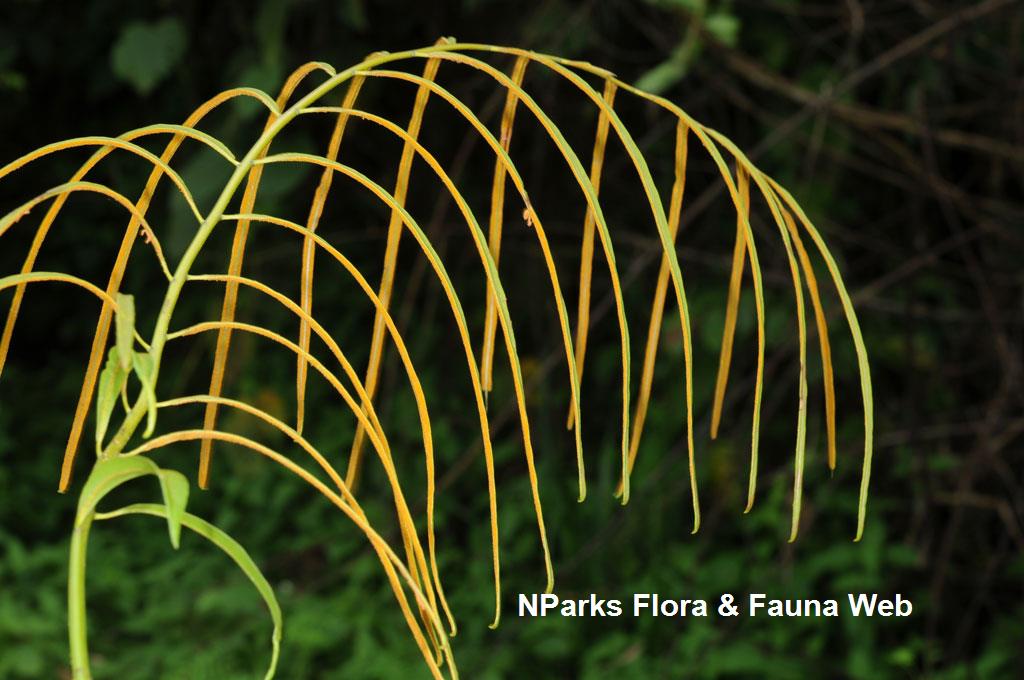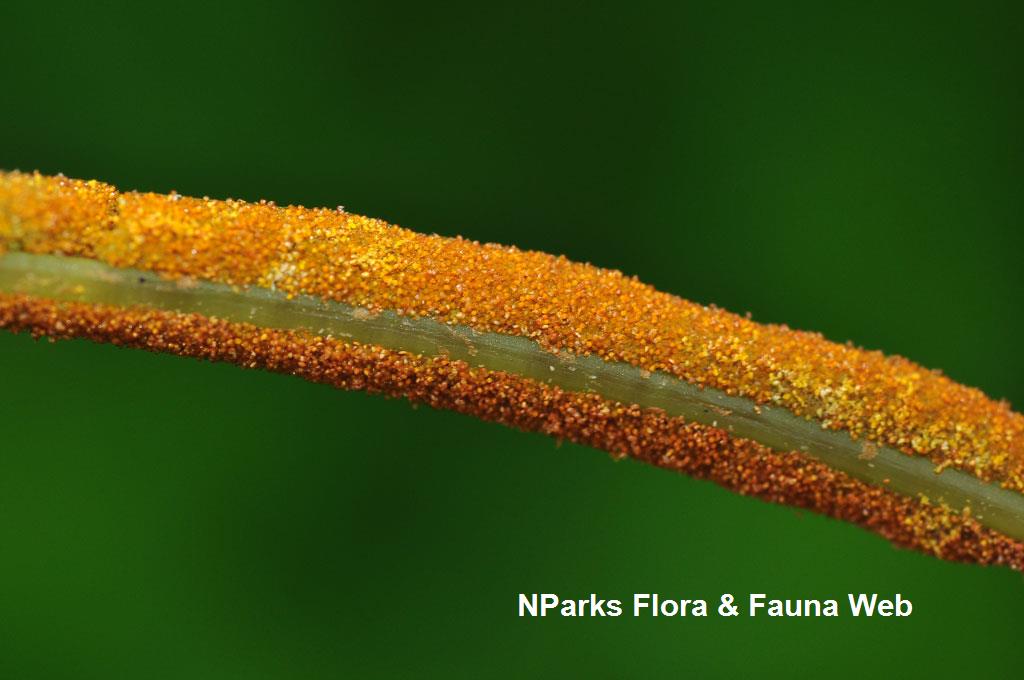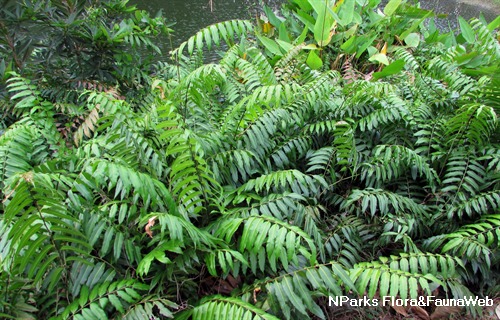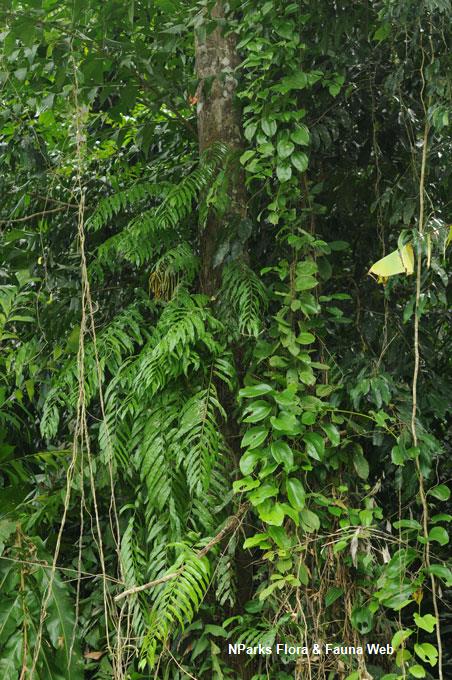
Back
Stenochlaena palustris (Burm.f.) Bedd.
| Family Name: | Blechnaceae |
| Common Name: | Climbing Fern, Akar Paku, Paku Ranu, Paku Miding, 光叶藤蕨 |
Stenochlaena palustris or Climbing Fern is a climbing fern native to Singapore. It has pinnate fronds up to 80 cm long, deep reddish when juvenile. The leaflets of sterile fronds are lance to broadly lance-shaped with toothed margins while the leaflets of the fertile fronds are extremely narrow, up to 0.3 cm wide. The sori are produced only at top of the plant, covering almost the entire leaflet.
Name
Classifications and Characteristics
| Plant Division | Ferns & Lycophytes (Non-Seed Vascular Plants) (Fern) |
|---|---|
| Plant Growth Form | Epiphyte, Herbaceous Plant |
| Mode of Nutrition | Autotrophic |
Biogeography
| Native Distribution | North and South India, Southeast Asia, Polynesia to Australia |
|---|---|
| Native Habitat | Terrestrial (Freshwater Swamp Forest, Primary Rainforest, Secondary Rainforest) |
| Preferred Climate Zone | Tropical, Sub-Tropical / Monsoonal |
| Local Conservation Status | Native to Singapore (Least Concern (LC)) |
Description and Ethnobotany
| Growth Form | It is a climbing fern with a scrambling habit up to 10 m, rarely seen as a terrestrial plant in the wild. |
|---|---|
| Foliage | Frond are well spaced apart, mature ones are stiff, leathery and dark green while young fronds are deep reddish coloured. The fronds are pinnate compound, producing two types of fronds, sterile and fertile fronds. The sterile fronds have wider, lance to broadly lance-shaped leaflets with toothed margins while the fertile fronds are extremely narrow, tends to droop, measuring about 20 cm long, 0.3 cm wide with smooth margins. Both types grow to 80 cm long, have 8 - 15 pairs of leaflets and 1 terminal leaflet. |
| Reproductive Parts - non-flowering plant | Sori are long, linear, found on each side of the midrib almost covering the entire width of the leaflet. They tend to only be produced on the top of the plant. |
| Others - Plant Morphology | Rhizomes are green, long-creeping, 4-7 mm wide, dark, small circular scales are most prominent at the growing tips, covering the ends completely. |
| Habitat | Occurs in freshwater swamp forests, behind mangroves, along rivers, marshes, on floating vegetation, lowland rainforest, also found in drier places free from flooding from sea level to 300 m in altitude. <1,2> |
| Cultivation | It can be propagated by spores. It tolerates full sun however prefers partial shade conditions. |
| Etymology | Genus Stenochlaena means "narrow-cloak" and refers to the sporangia covering the entire surface of the linear fertile pinnae. Species palustris means "of swampy ground". |
| Ethnobotanical Uses | Edible Plant Parts : Edible Leaves Food (Fruit or Vegetable): The young fronds are collected as a vegetable and fried with sambal belacan. Others: A durable rope can be made from the stems. |
Landscaping Features
| Desirable Plant Features | Ornamental Foliage |
|---|---|
| Landscape Uses | Parks & Gardens, Vertical Greenery / Green Wall |
| Usage Hazard - Cons | Spines/Thorns - Leaf |
Fauna, Pollination and Dispersal
| Seed or Spore Dispersal | Abiotic |
|---|
Plant Care and Propagation
| Light Preference | Semi-Shade |
|---|---|
| Water Preference | Moderate Water |
| Rootzone Tolerance | Moist Soils |
| Propagation Method | Spore, Division |
Foliar
| Foliage Retention | Evergreen |
|---|---|
| Mature Foliage Colour(s) | Green |
| Prominent Young Flush Colour(s) | Red |
| Foliar Type | Compound (Odd-Pinnate) |
| Foliar Attachment to Stem | Petiolate |
| Foliar Shape(s) | Non-Palm Foliage (Lanceolate, Oblanceolate) |
| Foliar Margin | Serrate / Toothed, Entire |
| Foliar Apex - Tip | Acuminate, Acute |
| Foliar Base | Cuneate, Oblique / Asymmetrical |
References
| References | <1> Nooteboom, H.P. (2012). Blechnum. In: Nooteboom, H.P. (ed.) Blechnaceae. Flora Malesiana, ser. 2, Pteridophyta, vol. 4, pp. 75. Leiden: Rijksherbarium <2> Tagawa, M. & Iwatsuki, K. (1985). Flora of Thailand, vol. 3(2), pp. 259-260. Bangkok: The Forest Herbarium, Department of National Parks, Wildlife and Plant Conservation. |
|---|
Image Repository
Others
| Master ID | 30436 |
|---|---|
| Species ID | 4745 |
| Flora Disclaimer | The information in this website has been compiled from reliable sources, such as reference works on medicinal plants. It is not a substitute for medical advice or treatment and NParks does not purport to provide any medical advice. Readers should always consult his/her physician before using or consuming a plant for medicinal purposes. |

.jpg)
.jpg)
.jpg)
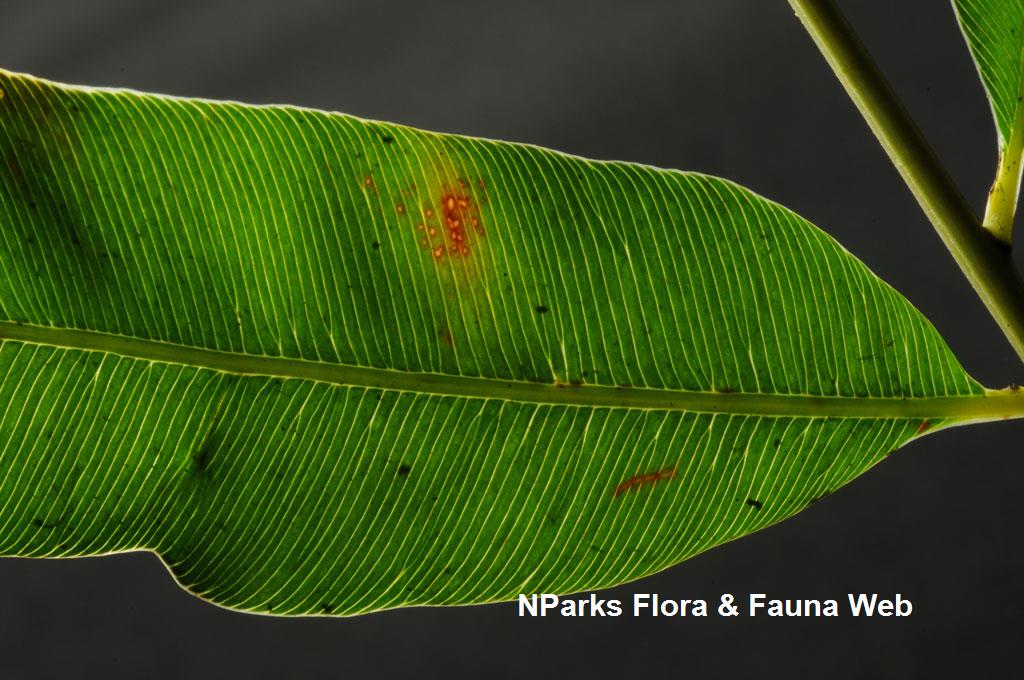
-tp_8314.jpg)
